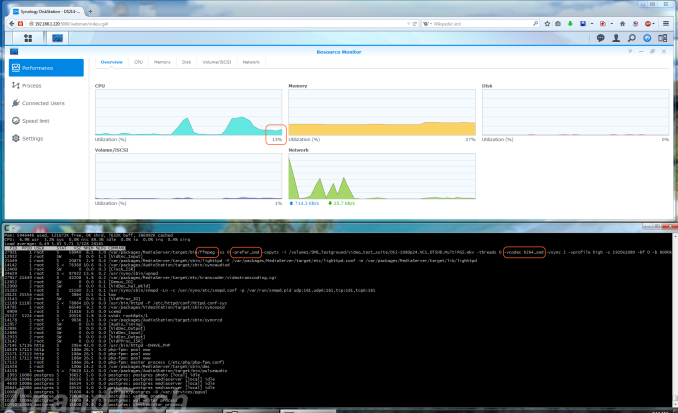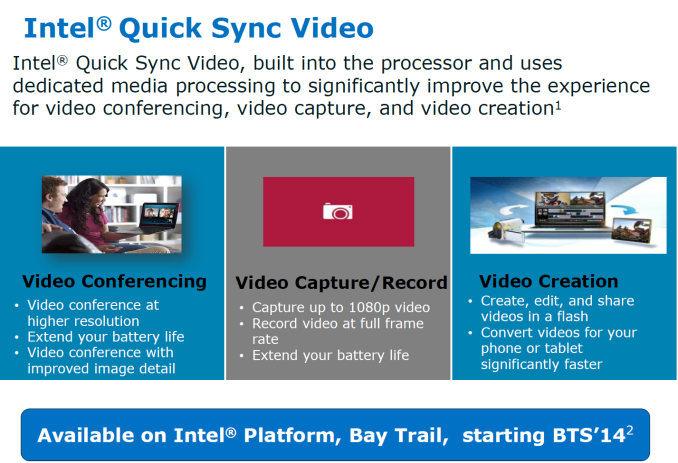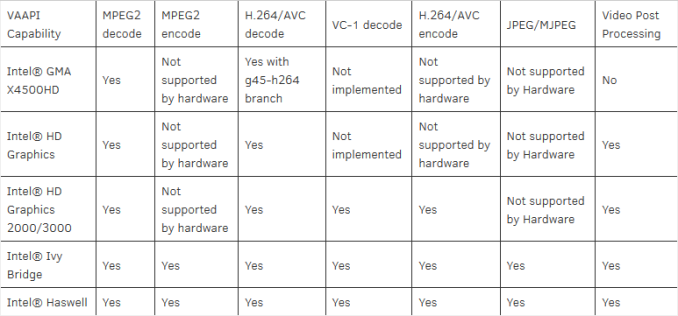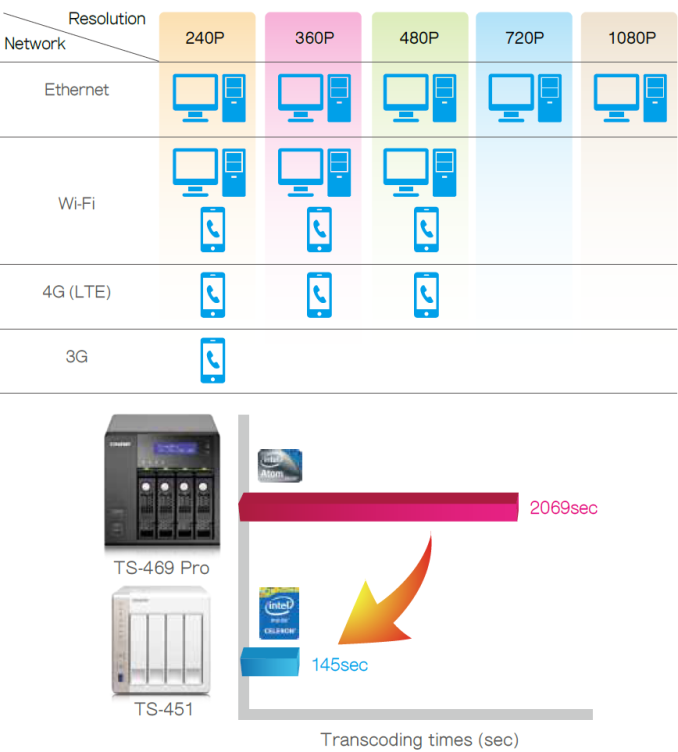QNAP TS-x51 NAS Series: Intel Quick Sync Gets its Killer App
by Ganesh T S on June 22, 2014 6:45 PM ESTHardware Accelerated Transcoding for Media Applications
One of the often-requested features from NAS units that act as media servers is the ability to transcode existing videos to better fit the requirements of the playback device. The popularity of Plex Media Server (which uses ffmpeg for transcoding) amongst consumers is an indication of the market demand for this feature. SoC companies as well as NAS vendors have been trying to address this problem in multiple ways.
Back at CES 2012, I saw Applied Micro's PhiPhi transcoding NAS platform, where the NAS SoC talked to a dedicated Zenverge transcoding chip to achieve the requirements. Unfortunately, I believe the reference design was never taken up by any NAS vendor. In the meanwhile, they continued to take efforts to include the Plex Media Server as a package installable on the NAS.
Evansport Makes the First Move
Intel entered into the picture with their Evansport NAS platform in March 2012. Based on their Berryville STB SoC, it also happened to have a H.264 encoder in addition to a multi-format decoder (giving it the capability to act as a transcoder). We have been pretty bullish on Evansport, having reviewed devices from all of Intel's announced partners (Asustor, Synology and Thecus). While Asustor and Thecus focused on the decoder aspects only, Synology was the only one to utilize the unique hardware transcoding feature.

Synology's Custom ffmpeg Build for Transcoding using Evansport
In order to utilize the transcoder block, Synology had to prepare a custom build of ffmpeg. Given that Intel hasn't announced any follow-ups to either Berryville or Evansport, it is not clear what the future of this series would be. In this situation, it was no surprise that the three partners had nothing new to announce in this lineup at either CES or Computex.
Bay Trail-D and Quick Sync Take Over
QNAP was one of the major NAS vendors who opted out of using Evansport. With the introduction of the TS-x51 series, I can clearly see why they decided to pass it up. One of the major reasons for Evansport's existence in addition to the regular Atom-based NAS units was the fact that a SoC configuration would reduce BOM cost for the vendors. With the Silvermont-based Atoms (which are SoCs), this advantage goes away. While Avoton and Rangeley are great for high-end SOHO / SMB NAS units as well as enterprise cold storage applications, certain consumer-focused aspects are absent. The most important amongst them are the multimedia focused features that Evansport provided. Obviously, cost is also a factor.
In our review of the DS214play, we had talked about how it would be better if Intel actually movied QuickSync over to the Berryville / Evansport follow-up. Instead of waiting for Intel to officially launch a storage platform (like they did for previous generation Atoms), QNAP has just gone forward and built a NAS family with the Bay Trail-D platform. At this point, QNAP's decision to skip Evansport in favour of devoting attention to Bay Trail-D seems to be making a lot of sense.
The Celeron J1800 is one of the first Bay Trail parts to come with Quick Sync, Intel's hardware H.264 encoder. QNAP's QTS OS is a Linux variant, and QNAP has decided to utilize the publicly available VA-APIs to access this Quick Sync engine.
Quick Sync Finds its Ideal Application
When Intel introduced its Quick Sync engine back with Sandy Bridge in 2010, it was pitched as a solution for users needing to transcode videos in a fast manner (particularly for mobile devices which couldn't handle the bit-rate or file sizes of the original stream). Support was restricted to paid software (such as CyberLink MediaEspresso) for a long time. It was only last year that HandBrake, the popular open source transcoding application, got Quick Sync support. However, purists and videophiles often were content with spending extra CPU time to get better quality encodes using x264's advanced options (and two-pass feature).
Quick Sync did make other GPU vendors sit up and put in video encoders on their GPUs too. NVIDIA came out with NVENC and AMD put in VCE. While NVIDIA seemed to have found its niche with recording game play in real-time, VCE is yet to gain as much traction. In addition to HandBrake support, integration into open source screen recorders (such as CamStudio) would help drive up adoption of the Quick Sync encoder in the PC space. Currently, even though Quick Sync was originally meant to be used as a transcoder, I wouldn't be surprised if Eric Gur's Quick Sync decoder (which is part of LAV Filters) was found to be used by more consumers. In any case, most of the interesting open source applications utilizing the Quick Sync hardware features have been restricted to Windows.
On Linux, Intel contributes extensively to the VA-API open source library / API specifications for video processing. Despite not being specifically mentioned, the documentation (table reproduced below) suggests that VA-API's H.264 encode capabilities are tied to the presence of the Quick Sync engine in the processor.
Wowza is one of the commercial applications which takes advantage of the Quick Sync engine on Linux. Downloading the driver package makes it clear that VA-API is being utilized. In the TS-x51 series, QNAP takes advantage of Quick Sync in two ways. The user can pre-transcode video files into different resolutions (where the use-case is similar to Handbrake), but the killer method is real-time transcoding for streaming media (using its mobile app or to a DLNA renderer).
Consumers have long been clamouring for Plex to take advantage of the Quick Sync engine, but the developers have been quite hesitant - deciding to focus on being on as many platforms as possible, rather than optimizing for platforms on which Intel Quick Sync is available. The rapid rise in user-generated media and the evolution of the mobile lifestyle has brought to fore the necessity for low power real-time media transcoding. Quick Sync (particularly in low power SoCs such as the Bay Trail-D / -M) perfectly fits the bill and QNAP's efforts to harness this feature deserves recognition.













49 Comments
View All Comments
rikm - Sunday, June 22, 2014 - link
the slide says "All new tubro" , kind of like turbo, but not quite that fast?wintermute000 - Sunday, June 22, 2014 - link
look forward to benches + real world transcoding testing.In particular want to see if everything is covered or there are any notable exceptions in terms of codec/container
SilthDraeth - Sunday, June 22, 2014 - link
Tubro, faster than snailro, just barely.ganeshts - Monday, June 23, 2014 - link
Didn't see that typo in their marketing brochure, to be honest :)Just spent some time fixing up the image at my end, so it should be OK now.
[-Stash-] - Monday, June 23, 2014 - link
Quick, hit the Turbo Button!steveoat - Sunday, June 22, 2014 - link
Looks interesting. What will be the costs of the 4 and 6 bay units?DanNeely - Sunday, June 22, 2014 - link
Probably similar to that of their current x69 series which are $540/712 for the bay and $782/925 for the 6 bay models on Amazon depending on if you go with the L or Pro models.Skarn - Sunday, June 22, 2014 - link
I'll be looking forward to seeing a full review of these units once samples become available. I'd especially like to know if the GPU driver baked in to drive the HDMI port fix the tearing problems I've seen on Sandy Bridge GPUs. While the feature set is sufficient that I'd be interested in these units despite this issue, I find tearing quite bothersome. I'd also be interested in seeing a full list of supported video codecs.ganeshts - Monday, June 23, 2014 - link
I wouldn't hold my hopes too high.. Intel GPUs' Linux drivers for video playback have historically been 'unreliable'. (That is why I wasn't too enthused about XBMC and HDMI output on the Evansport-based NAS units from Thecus and Asustor).That said, the list of supported codecs for transcoding input would definitely be something to evaluate and look into in greater details.
haardrr - Monday, June 23, 2014 - link
the latest intel drivers for linux 14.04 are amazing... (at least for the mythtv)...i know mythtv is NOT the same as a NAS box...
BUT, if the OS on this NAS is 14.04 (or similiar) you should not have any of the problems you have described.